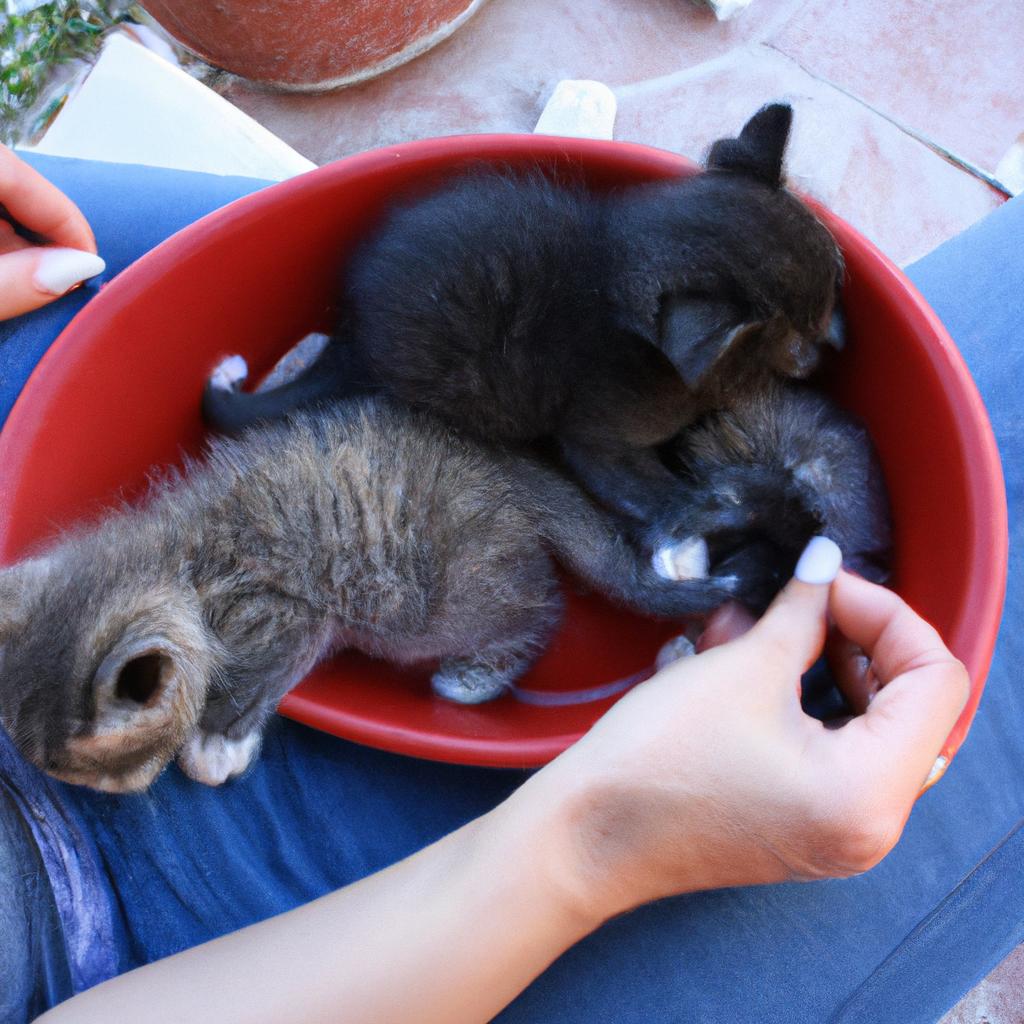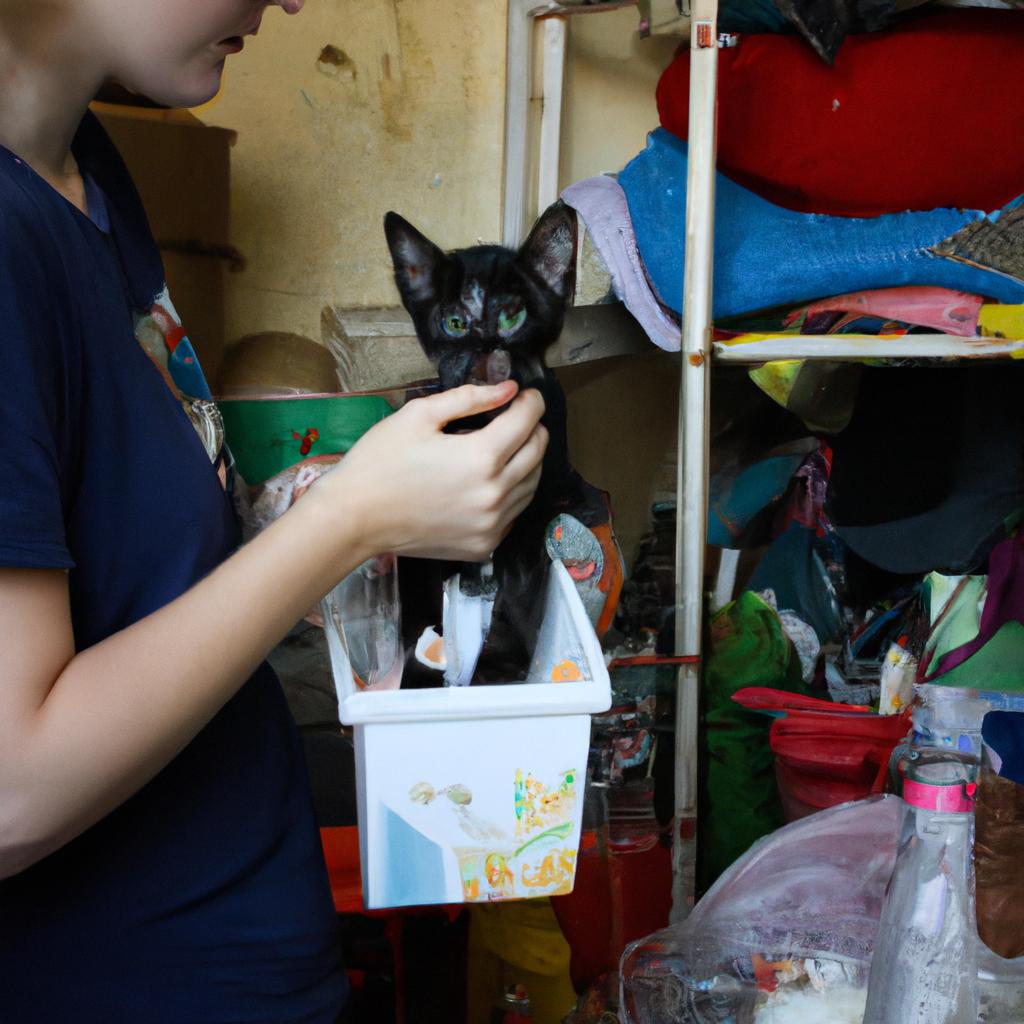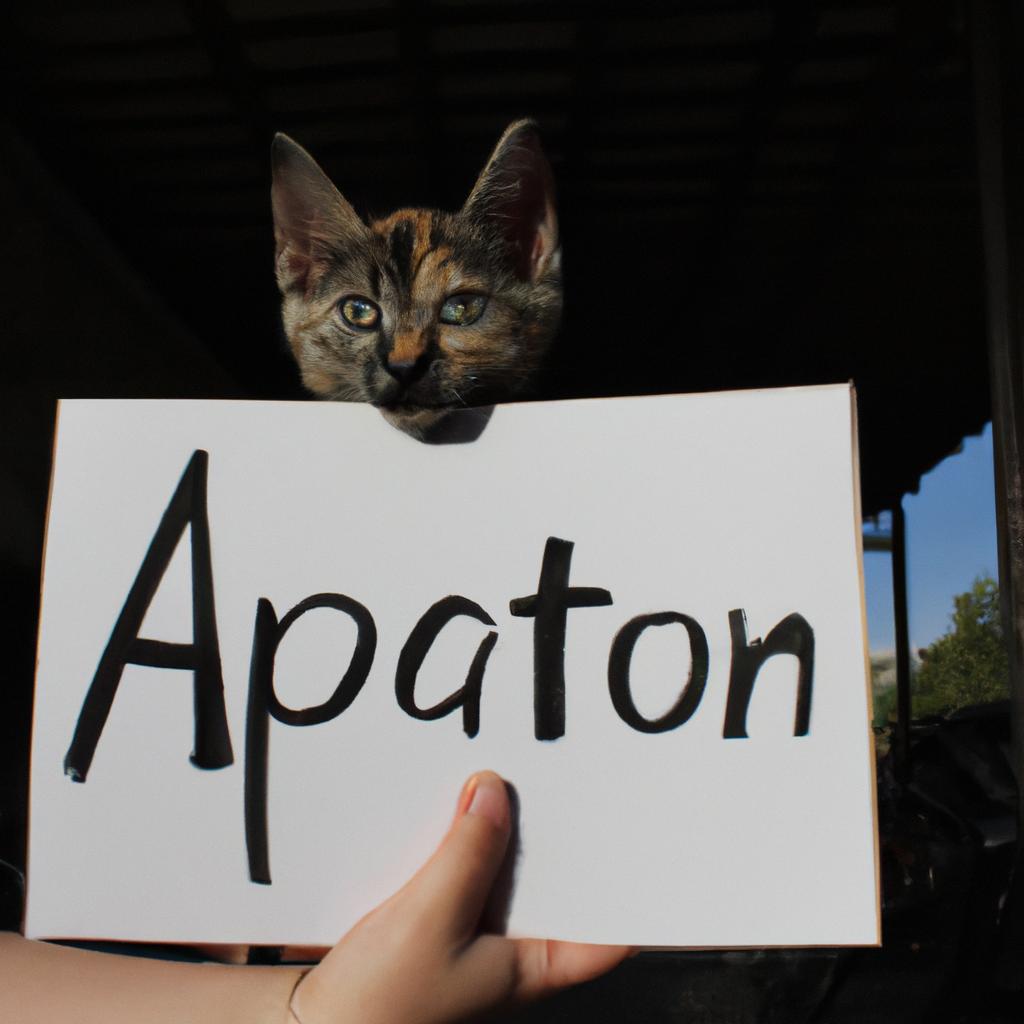Cat rescue foster care programs play a crucial role in providing temporary homes and necessary care for abandoned or stray kittens. However, ensuring the well-being of these vulnerable felines requires more than just offering them shelter. It involves comprehensive training to equip foster caregivers with the knowledge and skills needed to address their unique needs. This article aims to provide a comprehensive guide on kitten care training within cat rescue foster care programs, focusing on essential aspects such as nutrition, socialization, and medical care.
Imagine a scenario where a group of volunteers at a local cat rescue organization takes in an adorable litter of six-week-old kittens found abandoned on the streets. While their intentions are noble, they soon realize that caring for these tiny creatures is not as straightforward as anticipated. The kittens require specialized attention regarding feeding schedules, proper handling techniques, and early socialization experiences to ensure their healthy development into well-adjusted adult cats. Recognizing this need, many cat rescue organizations now prioritize implementing structured kitten care training programs within their foster care initiatives.
By providing practical guidance and evidence-based strategies, this article aims to support cat rescue foster caregivers in effectively addressing the specific challenges associated with raising orphaned or abandoned kittens. From understanding the nutritional requirements of growing kittens to fostering positive human-animal interactions through social socialization, this guide will cover all the essential aspects of kitten care training.
-
Nutrition: Feeding plays a crucial role in the healthy development of kittens. Foster caregivers should receive training on appropriate feeding schedules, types of food suitable for different age groups, and proper portion sizes. They should also learn about potential dietary issues and how to address them, such as dealing with picky eaters or managing allergies.
-
Health Care: Kittens require regular veterinary check-ups and vaccinations to ensure their well-being. Foster caregivers should be trained on recognizing common health problems in kittens, such as respiratory infections or parasites, and understanding when medical intervention is needed. They should also learn how to administer medication if necessary.
-
Socialization: Early socialization experiences are vital for kittens to become well-adjusted adult cats. Foster caregivers should be educated on introducing kittens to various stimuli, including different people, animals, and environments. Training can include techniques for positive reinforcement, handling exercises, and creating a stimulating environment that encourages exploration and play.
-
Behavioral Training: Kittens may exhibit certain behaviors that need guidance and correction. Foster caregivers should receive training on promoting desirable behaviors like using litter boxes and scratching posts while discouraging destructive habits like biting or excessive meowing. Techniques such as clicker training or reward-based methods can be taught to foster positive behavior.
-
Environmental Enrichment: Creating an enriching environment is essential for the physical and mental well-being of kittens. Foster caregivers should learn about providing appropriate toys, scratching surfaces, hiding spots, and climbing structures to satisfy the natural instincts of growing cats.
-
Communication: Effective communication between foster caregivers and the rescue organization is crucial for ensuring timely support when needed. Volunteers should be trained on maintaining clear lines of communication regarding any concerns or changes in the kittens’ behavior or health status.
-
Adoption Preparation: Part of caring for foster kittens involves preparing them for adoption into forever homes. Foster caregivers should be trained on screening potential adopters, conducting adoption interviews, and providing information about the kittens’ personalities and needs to ensure successful matches.
By implementing comprehensive kitten care training programs within cat rescue foster care initiatives, organizations can equip their volunteers with the necessary knowledge and skills to provide optimal care for these vulnerable felines. This training not only benefits the kittens but also enhances the overall success of finding them loving forever homes.
Preparing for a New Kitten
Imagine welcoming a tiny ball of fur into your home, eager to shower it with love and care. Preparing for a new kitten is an essential step in ensuring their well-being and happiness as they adjust to their new environment. By following these guidelines, you can create a smooth transition for both you and your newest companion.
Firstly, it’s crucial to gather all the necessary supplies before bringing your kitten home. This includes items such as a litter box, high-quality cat food, water bowls, bedding, toys, scratching posts, and grooming tools. Having these essentials ready will provide a sense of security and comfort for the little one from day one.
Secondly, make sure to designate a safe space within your home where your kitten can retreat when feeling overwhelmed or tired. Set up this area with cozy blankets or beds, keeping it separate from any potential hazards like open windows or exposed wires. Creating a designated spot ensures that your furry friend has somewhere comforting to relax and call their own.
To further enhance the emotional bond between you and your kitten during this transitional period, consider incorporating some interactive playtime activities into your routine. Engaging in regular play sessions not only provides exercise but also strengthens the bond between you and your feline companion. Consider using feather wands or puzzle toys that stimulate their natural instincts while providing mental stimulation.
Lastly, remember to be patient and understanding as your new kitten adjusts to its surroundings. Just like humans, each cat has its own unique personality traits and preferences. Some may adapt quickly while others might take more time getting comfortable in their new environment. Be prepared to offer reassurance and support whenever needed through gentle interactions and providing additional comforts if required.
Ensuring the safety of your new bundle of joy should be at the top of your priority list when creating their living space. Here are some key steps you can take:
- Secure electrical cords and outlets to prevent chewing or accidental shocks.
- Keep toxic plants out of reach, as some can be harmful if ingested by cats.
- Store household chemicals in locked cabinets to avoid any accidental exposure.
- Use window screens or safety nets to prevent falls from open windows.
By taking these precautionary measures, you’ll create a safe environment for your kitten to explore and thrive in without unnecessary risks.
Creating a Safe Environment
Imagine bringing home a tiny, fragile kitten rescued from the streets. The responsibility of providing a safe environment for your new furry friend cannot be overemphasized. By taking proactive measures and creating a secure space, you can ensure that your kitten feels protected and loved in their new surroundings.
To begin with, it is crucial to eliminate any potential hazards that could harm your curious little companion. Keep electrical cords out of reach or neatly secured against walls using cord covers. Store household cleaners, medications, and chemicals in locked cabinets or high shelves inaccessible to kittens. Remember, what may seem harmless to us might pose serious risks to these small creatures.
In addition to removing dangers, consider implementing the following measures to create an optimal living environment for your kitten:
- Provide vertical spaces such as cat trees and scratching posts so they can exercise their natural climbing instincts.
- Set up hiding spots like cozy beds or enclosed boxes where they can retreat when feeling overwhelmed.
- Offer interactive toys that stimulate playfulness and mental engagement.
- Establish litter box stations in multiple locations throughout the house to encourage proper elimination habits.
Creating A Safe Environment For Your New Kitten
| Safety Precautions | Vertical Spaces | Hiding Spots | Interactive Toys |
|---|---|---|---|
| Remove hazards | Cat trees | Cozy beds | Playful mice |
| Secure cords | Scratching posts | Enclosed boxes | Puzzle feeders |
| Lock away toxins | Wall-mounted shelves | Blanket forts | Feather wands |
| Childproof doors | Window perches | Cat tunnels | Treat-dispensing toys |
By ensuring the safety of your home environment through these precautions and provisions, you will provide comfort and security essential for your new kitten’s well-being. In doing so, you are setting the stage for a harmonious and healthy relationship with your feline companion.
Transitioning into the subsequent section about “Feeding and Nutrition,” it is important to consider not only their safety but also their dietary needs. Proper nutrition plays a vital role in maintaining your kitten’s overall health and development.
Feeding and Nutrition
Transitioning from the previous section on creating a safe environment, it is essential to provide proper feeding and nutrition for kittens in cat rescue foster care programs. Let’s consider an example of a recently rescued kitten named Luna. After undergoing medical checks and being placed in a loving foster home, Luna’s caregivers needed to ensure her nutritional needs were met.
Feeding and nutrition play a crucial role in the development and overall well-being of kittens like Luna. To guide cat rescue foster care programs, here are some key considerations:
-
Age-appropriate diets: Kittens have different nutritional requirements at various stages of their growth. It is vital to provide them with specific formulas designed for their age group. For instance, during the first few weeks of life, they require milk replacement formulas rich in essential nutrients such as colostrum.
-
Scheduled feedings: Establishing a consistent feeding schedule helps kittens develop healthy eating habits while ensuring they receive adequate nourishment throughout the day. Offering small portions multiple times can prevent overfeeding or underfeeding.
-
Nutrient-rich meals: High-quality commercial kitten food offers balanced nutrition necessary for their growth and development. Look for products labeled as complete and balanced by reputable brands that meet industry standards.
-
Hydration awareness: Proper hydration is equally important as providing nutritious meals. Ensure fresh water is available at all times, especially during warmer months or if you notice signs of dehydration.
- Providing appropriate nutrition ensures optimal health.
- A well-fed kitten has more energy to explore its surroundings.
- Good nutrition supports immune system function.
- Adequate intake promotes healthy weight gain and muscle development.
Additionally, we present a table highlighting common nutrient requirements for growing kittens:
| Nutrient | Function | Source |
|---|---|---|
| Protein | Builds and repairs tissues | Meat, fish, eggs |
| Calcium | Promotes healthy bone development | Milk, cheese, yogurt |
| Fat | Provides energy and aids absorption of vitamins | Oils, fatty acids |
| Vitamin A | Supports vision and immune system function | Carrots, liver |
In summary, ensuring proper feeding and nutrition for kittens like Luna is vital in cat rescue foster care programs. By offering age-appropriate diets, establishing scheduled feedings, providing nutrient-rich meals, and promoting hydration awareness, caregivers can contribute to the overall well-being and growth of these adorable feline companions.
Transitioning into the next section on socializing and bonding with kittens without explicitly stating “step,” it is important to consider their emotional needs as well.
Socializing and Bonding
Transitioning from the previous section on feeding and nutrition, it is important to consider the socializing and bonding aspect of kitten care. Building strong relationships with kittens not only helps them feel safe and loved but also prepares them for a successful adoption process. Let’s explore some strategies that can be implemented in cat rescue foster care programs to facilitate socialization and bonding.
Imagine a scenario where a timid six-week-old rescued kitten named Luna arrives at a foster home. Luna has had limited human interaction and is hesitant around people. To help her overcome her fear and build trust, the foster caregiver spends time sitting quietly near Luna’s hiding spot, allowing her to observe without feeling threatened. Gradually, the caregiver initiates gentle interactions by offering treats or toys while speaking softly to Luna. This approach helps Luna associate positive experiences with human presence, paving the way for further socialization.
To effectively socialize kittens like Luna, here are some key considerations:
- Patience: Each kitten has its own unique personality and may require different amounts of time to become comfortable with humans.
- Positive reinforcement: Reward desirable behaviors such as approaching humans or engaging in playtime activities with treats or praise.
- Gradual exposure: Introduce new stimuli slowly and gradually to prevent overwhelming the kitten.
- Playtime: Engage in interactive play sessions using toys designed specifically for kittens, promoting physical activity and building bonds.
| Body Language | Description |
|---|---|
| Ears forward | Indicates attentiveness or curiosity |
| Tail held up straight | Signifies confidence |
| Purring | Shows contentment or relaxation |
| Hissing | Suggests fear or aggression |
By understanding these cues, caregivers can better assess a kitten’s emotional state during socialization efforts.
In preparation for upcoming sections on litter box training, ensuring proper socialization and bonding lays a solid foundation for kittens to learn and adapt to new environments. Building trust between the kitten and caregiver will facilitate a smoother transition into litter box training, where the focus shifts towards teaching them appropriate elimination habits.
Litter Box Training
To ensure the successful integration of a rescued kitten into its new environment, socialization and bonding play a vital role. By providing proper guidance and attention, you can help your foster kittens develop trust and establish healthy relationships with humans and other animals.
Socializing and Bonding Techniques:
Encouraging positive interactions between kittens and humans is crucial for their emotional well-being. Here are some effective techniques to facilitate socialization and bonding:
- Gentle handling: Gradually introduce touch by starting with brief strokes on the back or chin, observing the kitten’s response to gauge comfort levels.
- Playtime engagement: Interactive toys such as feathers or string wands can promote exercise while building trust through engaging activities.
- Exposure to various stimuli: Introduce different environments, sounds, smells, and textures to acclimate kittens to diverse experiences early on.
- Controlled introductions: When introducing new people or animals, create calm environments where all parties feel safe; supervise interactions closely during initial encounters.
Case Study Example:
Consider a hypothetical scenario involving an apprehensive rescue kitten named Luna. Initially fearful of human interaction due to past trauma, Luna’s foster caregiver followed these socializing techniques diligently. Over time, gentle handling helped Luna grow comfortable with physical contact, gradually allowing longer periods of petting without fear or anxiety. Slowly incorporating interactive play sessions boosted Luna’s confidence in her surroundings. As she became more accustomed to various stimuli in controlled settings, Luna began displaying curiosity towards new objects rather than reacting with fear.
Emotional Bulleted List (markdown format):
The following bullet points highlight the emotional benefits of successful socialization and bonding:
- Increased feelings of safety and security
- Improved overall mental health
- Enhanced ability to form trust-based relationships
- Reduced stress levels
Emotional Benefits
| Emotional Benefits |
|---|
| Increased feelings of safety and security |
| Improved overall mental health |
| Enhanced ability to form trust-based relationships |
| Reduced stress levels |
Transition into the subsequent section about “Healthcare and Vaccinations”:
By establishing a solid foundation of socialization and bonding, you are setting your foster kittens up for success in their new homes. However, it is essential to prioritize their healthcare needs as well. Providing proper veterinary care, vaccinations, and preventative measures will help ensure their long-term well-being. Let’s explore these crucial aspects in the next section.
Healthcare and Vaccinations
Ensuring a safe and healthy environment for kittens goes beyond litter box training. Proper healthcare and vaccinations are essential to prevent the spread of diseases and protect these vulnerable feline companions. Let’s explore the importance of healthcare and vaccinations in cat rescue foster care programs.
Example:
To illustrate the significance of proper healthcare, consider a hypothetical case involving a rescued kitten named Luna. Upon arrival at the foster home, Luna appeared healthy but started exhibiting signs of respiratory distress after a few days. The foster caregiver promptly took her to a veterinarian who diagnosed her with an upper respiratory infection that required immediate treatment. This incident highlights the crucial role that regular veterinary check-ups and vaccinations play in safeguarding the well-being of rescue kittens.
Here are key considerations to keep in mind when it comes to healthcare and vaccinations in cat rescue foster care programs:
- Regular Veterinary Check-Ups: Schedule routine visits with a trusted veterinarian who specializes in feline health. These check-ups allow for early detection of potential illnesses or underlying conditions before they become severe.
- Vaccination Protocols: Follow recommended vaccination schedules tailored specifically for young kittens. Vaccines commonly administered include those against panleukopenia (feline distemper), rhinotracheitis, calicivirus, chlamydia, and rabies.
- Preventive Medications: Administer preventive treatments such as dewormers, flea control products, heartworm prevention medication (if applicable), and topical medications designed to combat ear mite infections.
- Spaying/Neutering: Discuss spaying/neutering options with your veterinarian once the kitten reaches an appropriate age. Sterilization not only prevents unwanted litters but also offers various health benefits for cats.
Table – Common Vaccinations for Kittens:
| Vaccine Name | Disease(s) Covered |
|---|---|
| FVRCP | Panleukopenia, Rhinotracheitis, Calicivirus |
| FeLV | Feline Leukemia Virus |
| Rabies | Rabies |
By prioritizing healthcare and vaccinations in cat rescue foster care programs, we can ensure that kittens like Luna have the best chance at a healthy life. Regular veterinary check-ups, proper vaccination protocols, preventive medications, and spaying/neutering are essential components of responsible kitten care.
Remember: The well-being of these vulnerable felines depends on our commitment to providing them with the necessary medical attention they need throughout their journey towards finding forever homes.




